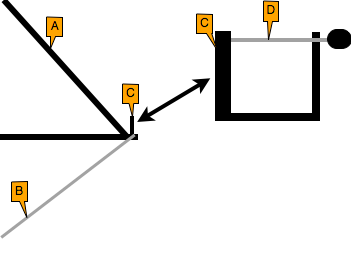Rowing Terminology
Boat Orientation and Positions

Bow- The front of the boat when moving.
Stern- The back of the boat
Port- When looking from stern to bow, the left side of the boat; the right side from the rowers perspective
Starboard- When looking from stern to bow, the right side of the boat; the left side from the rowers perspective
Seats in the boat- The seat positions in a boat are numbered from bow to stern, with the seat closest to bow as 1 and increasing down to stern
Bow seat- Another term for the 1 seat; the seat closest to the bow of the boat
Stroke seat- The highest numbered seat in a boat. This seat is responsible for setting the stroke rate of the boat. In an 8, this is would be 8 seat.
Coxswain- The shorter, lighter member of the boat that does not row, but instead is responsible for steering the boat and
Parts of a Boat

Not pictured: Vents, Keel, Ribs, Skeg, and cox box. Bow ball shown in previous diagram
-
1.Hull- Main body of the shell
-
2.Deck- the far ends of the boat where no one sits. They contain empty space where air is trapped to help increase the buoyancy of the boat.
-
3.Gunwales- top, outer edge of the boat
-
4.Vents- Openings on the decks to allow air in to dry out the inside
-
5.Keel- The piece of wood that runs down the center of the boat from bow to stern. The “spine” of the boat.
-
6.Ribs- Horizontal pieces that run perpendicular to the spine on the inside of the boat.
-
7.Skeg- Flat piece of metal that is attached to the bottom of the hull and help stabilizes the boat
-
8.Seat- seat mounted on wheels where the rower sit. The seat slides up and down the slides during the stroke
-
9.Slides/Tracks- Metal rails that the seats roll back and forth on
-
10.Foot stretcher- the adjustable footplate where the shoes are attached. The stretchers can be adjusted to accommodate for different leg lengths.
-
11.Rigger- The rigger is a metal piece that stretched out from the boat. It provides a pivot point for the oar as it moves back and forth. RIT has Euro style riggers for most of their boats.
-
12.Bow ball- The foam ball on the front of the bow
-
13.Cox Box- The electronic device that plugs into the speakers of the boat and records stroke rate during the race
The Euro Rigger

-
A.Rigger Frame- The solid metal part of the rigger that pro
-
B.Backstay-The flexible back arm of the rigger
-
C.Oar Lock- “U” shaped piece where the oar sits, rotates on the rigger
-
D.Gate- metal screw along the top of the oarlock that keeps the oar in the oarlock
The Oar

-
A.Blade- Wide end of the oar that pushed the water
-
B.Shaft- The long, thin, wooden section that connects the oar to the handle
-
C.Handle- Opposite of the blade where the rower grips the oar.
-
D.Sleeve- plastic cover around shaft that rests inside the oarlock. Allows the oar to rotate so the blade stays at 90º rotations and protects the wood from breaking due to the pressure by pivoting the oar in the oarlock during the stroke.
-
E.Collar- plastic ring attached to the sleeve that is wider than the oarlock to help keep the oar blade the proper distance out from the boat